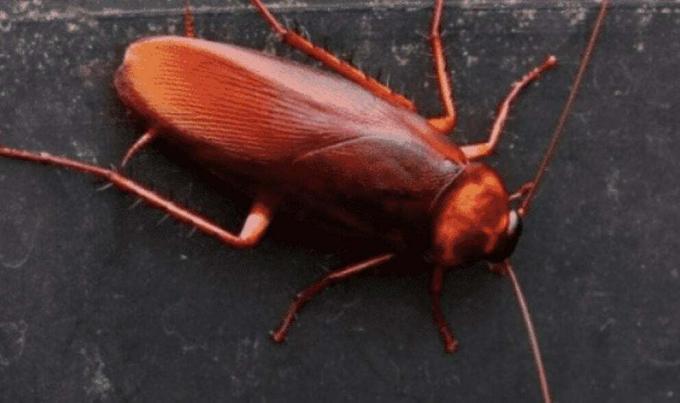Metamorphosis Process in Cockroaches
For this discussion, we will provide a review regarding Cockroach Metamorphosis which in this case includes Morphology, Process, Explanations & Pictures, so to better understand and comprehend, see the complete review below.
A. Understanding Cockroaches
Cockroaches are insects with an oval, dorso-ventrally flattened body shape. The head is hidden under the pronotum. The pronotum and wings are smooth, apparently hard, hairless and spiny, brown or dark brown in color. Cockroach body length varies greatly, ranging from 0.6-7.6 mm.
Cockroaches are an insect belonging to the order Orthoptera (two-winged) with the front wings covering the back wings and folding like paper.
Cockroaches consist of several genera, namely Blatella, Periplaneta, Blatta, supella And Blaberus. Some species of cockroaches are Blatella Germanica, Periplaneta Americana, Periplaneta Australasiae, Periplaneta Fuliginosa, Blatta Orientalies, And Supella Longipalpa.
Also see material about: Metamorphosis Process in Mosquitoes
B. Cockroach Morphology
The following are several cockroach morphologies, including the following:
Caput (Head)
On the head there is a mouth which is used to chew or chew food. There are a pair of compound eyes that can distinguish between dark and light.
On the head there is a pair of long antennae, sensory organs that can detect odors and vibrations in the air. When resting, the head is bent under the pronotum which is shaped like a shield.
Thorax (Chest)
On the chest there are three pairs of legs and a pair of legs which can enable cockroaches to fly and run quickly. There is a large plate-like structure that functions to cover the base of the head and wings behind the head, called the pronotum.
Abdomen (Stomach)
The body or stomach of a cockroach is a building and reproductive system. Cockroaches will contain their eggs until the eggs are ready to hatch. From the end abdomen there is a pair of cerci that act as sensory organs.
The cerci are directly connected to the feet via nerve ganglia abdomen (secondary brain) which is important in defense adaptation. If a cockroach senses disturbance in its cerci, its legs will move and run before the brain receives a sign or signal.
Also see material about: Metamorphosis Process in Frogs
C. Stages of the Cockroach Metamorphosis Process
Below are several stages of the Cockroach metamorphosis process, including the following:
Egg Process

The cockroach metamorphosis process begins with the egg stage. Cockroach eggs are obtained from the fertilization of female egg cells by male cockroach spermatozoa cells.
Female cockroach mothers generally lay the eggs they contain on the surface of the soil or rubbish. It is more common to find cockroach eggs laid in areas that are rarely visited by people.
In laying one egg, a mother cockroach can lay around 16 to 32 eggs. The eggs usually stick to each other because of the sticky liquid on their surface.
The black or brown eggs are usually also protected by a capsule shell called the ootheca. The oorheca is very hard so it can protect the egg from external impacts.
Cockroach eggs will hatch between 1 and 2 months depending on the type and species of the parent. From the hatched eggs, nymphs or young cockroaches will emerge.
Nymph Process

After the eggs hatch, nymphs or baby cockroaches will emerge. Very small nymphs resemble rice lice but are white. The nymphs can move freely looking for food until they grow and change color to brown. At the beginning of this phase, the nymph does not yet have wings.
Also see material about: Metamorphosis Process in Butterflies
In the cockroach metamorphosis process, the nymph phase goes through 60 days with 4 to 7 instars or skin changes. Each time they change their skin, the new nymph's skin will become harder.
New small wings begin to appear in the last instar phase before entering the imago phase. You can see a picture of a cockroach nymph and its growth until it becomes an adult cockroach in the illustration below.
Imago Process (Adult Cockroach)

Passing the last instar period, cockroach nymphs have started to have 2 pairs of wings. It is in this phase that the imago stage begins. The imago or adult insect of a cockroach has strong wings that enable it to fly here and there.
At the beginning of the imago phase, young cockroaches are smaller. It will grow bigger until it is ready to carry out the reproductive process with its partner.
The imago stage lasts for 200 days and can lay 8 to 20 eggs before finally dying.
D. Cockroach Bionomics
The following are several bionomics in cockroaches, including the following:
Mothering Place
Generally, cockroaches prefer dirty, damp and cool places such as in toilets, under piles of goods, in damp and smelly warehouses, or other dirty places.
His Way of Life
Cockroaches generally live in groups. They are active in looking for food at night and during the day they hide in crevices walls, door frames, inside bathrooms, cupboards, gutters, caves, sewing machines, televisions, radios, and tools other electronics.
Also see material about: Understanding Perfect and Imperfect Metamorphosis
With its flat body, if a cockroach feels disturbed or its life is threatened, it will hide its body in a narrow gap. Cockroaches can also use other methods to protect themselves from danger, namely by emitting a foul-smelling liquid.
Favorite Food
Cockroaches eat all types of food consumed by humans, especially those containing sugar and fat. Such as milk, cheese, meat, grains, sugar and chocolate. They also like cardboard, piles of books, cotton glue, blood, excreta and sputum.
Also See Other Materials: Definition of Biotic and Abiotic Natural Symptoms and Examples
That's the discussion about Metamorphosis Process in Cockroaches Hopefully this review can increase your insight and knowledge, thank you very much for visiting.
